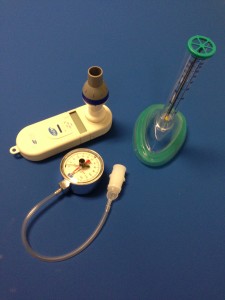By Lee Guion, MA, RRT, FAARC
Neurorespiratory Clinical Specialist
Although spirometry gives us the big picture on how lung muscles work together (diaphragm, intercostal, abdominal), additional measures refine our knowledge. Other lung function tests include:
MIP (maximum inspiratory pressure) is a more sensitive test of inspiratory muscle strength (internal intercostal and diaphragm). It measures the amount of negative pressure you can generate against against resistance (no air flow). Each inhalation is quick and forceful.
MEP (maximum expiratory pressure) measures the strength of expiratory muscles (external intercostal and abdomen). The maneuver is like MIP, only with quick, forceful exhalation. It measures the amount of positive pressure you can generate against resistance.
PCF (peak cough flow) measures expiratory flow during a cough and your ability to protect the airways from saliva, food and liquids. It is easily measured using a peak flow meter attached to a mask. It may be used instead of MEP as both track the strength of your expiratory muscles which are important for coughing and removing mucus and secretions from the lungs.
SNIP (sniff nasal inspiratory pressure) is a sensitive test of global inspiratory muscle strength. It is particularly useful if changes in speech and swallowing muscles lead to inaccurate or inconsistent spirometry test results. A small nasal probe is fitted for the size of one nostril. When directed by your tester you will quickly “sniff” which stimulates the diaphragm to move quickly and provides a negative pressure reading.
Capnography measures your exhaled carbon dioxide levels. As the lungs weaken it becomes more difficult to clear the lungs of this gas. Samples of your exhaled breaths are obtained using a small, two-pronged cannula placed in your nose (like nasal prongs used for oxygen delivery.) Results show how deeply you are breathing and if you have residual carbon dioxide levels at the end of your exhalations. Capnography also gives your respiratory therapist and physician an idea of how your body is adjusting to shallow breathing over time.
Pulse oximetry measures the percentage of oxygen attached to hemoglobin in your red blood cells. A small clips is placed on your index finger. It reads the amount of oxygen in the small vessels in your nail bed which reflects the amount of oxygen throughout the body.
ABGs (arterial blood gases) also measure oxygen and carbon dioxide levels. The information from this blood sample also tells clinicians the pH of your blood (normal levels are necessary for proper cellular function) and bicarbonate levels. (Carbon dioxide dissolved in the blood is acidic. It is buffered by bicarbonate, produced by the kidneys, so you can maintain normal blood pH levels.)
Unlike capnography and pulse oximetry described above, obtaining arterial blood samples requires drawing blood from the arteries under the wrist or the bend in the elbow. This test is not performed routinely, but may be prescribed at important junctures in your respiratory decline, prior to surgery, or to confirm capnography and oximetry values.
The tests described here, along with spirometry testing, are used to assess lung function and guide recommendations for treatment with bi-level positive pressure breathing (PAP), cough assistance, secretion management, and lung hyper-inflation. Future posts will cover these treatment options in detail.

